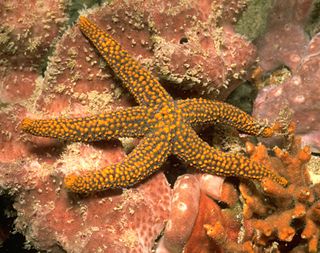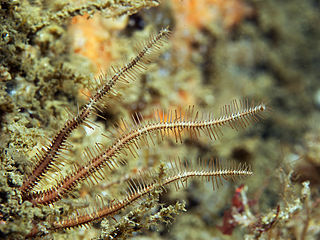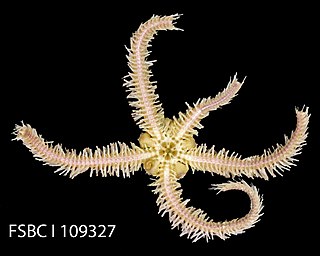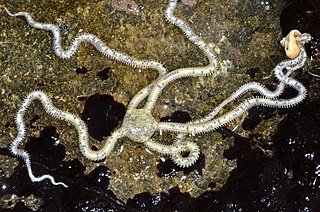Related Research Articles

Brittle stars, serpent stars, or ophiuroids are echinoderms in the class Ophiuroidea closely related to starfish. They crawl across the sea floor using their flexible arms for locomotion. The ophiuroids generally have five long, slender, whip-like arms which may reach up to 60 cm (24 in) in length on the largest specimens. From New Latin ophiurus, from Ancient Greek ὄφις + οὐρά.

Solaster paxillatus, the orange sun star, is a species of starfish found at varying depths in the northern Pacific Ocean. It is a natural predator of the starfish Asterias amurensis.

Ophiotrichidae are a family of ophiurid brittle stars within the infraorder Gnathophiurina.

Ophiocomina nigra, commonly known as the black brittle star or black serpent star, is a species of marine invertebrate in the order Ophiurida. It occurs in the north-eastern Atlantic Ocean, the North Sea and the Mediterranean Sea.

The sand star, Luidia foliolata, is a species of starfish in the family Luidiidae found in the northeastern Pacific Ocean on sandy and muddy seabeds at depths to about 600 m (2,000 ft).
Ophiothrix suensoni, Suenson's brittle star or the sponge brittle star, is a species of marine invertebrate in the order Ophiurida. It is found in the Caribbean Sea and Gulf of Mexico. It is included in the subgenus Acanthophiothrix making its full scientific name Ophiothrix (Acanthophiothrix) suensoni.

Echinaster spinulosus, the small spine sea star, is a species of sea star found in shallow parts of the western Atlantic Ocean, the Caribbean Sea and Gulf of Mexico.

Ophiura albida is a species of brittle star in the order Ophiurida. It is typically found on the seabed in the north eastern Atlantic Ocean and in the Mediterranean Sea and is sometimes known as the serpent’s table brittle star.

Ophionereis reticulata, the reticulated brittle star, is a brittle star in the family Ophionereididae. It is found in shallow parts of the western Atlantic, Caribbean Sea and Gulf of Mexico.

Ossicles are small calcareous elements embedded in the dermis of the body wall of echinoderms. They form part of the endoskeleton and provide rigidity and protection. They are found in different forms and arrangements in sea urchins, starfish, brittle stars, sea cucumbers, and crinoids. The ossicles and spines are the only parts of the animal likely to be fossilized after an echinoderm dies.

Ophiopsila aranea is a species of brittle star belonging to the family Ophiocomidae. It is the type species of the genus Ophiopsila

Amphiura chiajei is a species of brittle star belonging to the family Amphiuridae. It is found in the northeastern Atlantic Ocean and adjoining seas to a depth of 1,000 metres (3,300 ft). It digs itself into the soft sediment of the seabed and raises its arms into the water above to suspension feed on plankton. It was first described by the British naturalist Edward Forbes in 1843, and was named for the Italian zoologist Stefano Delle Chiaje (1794–1860).

Ophiocoma echinata, the spiny ophiocoma, is a species of brittle star belonging to the family Ophiocomidae. It is the type species of the genus Ophiocoma and is found in the tropical west Atlantic Ocean, the Caribbean Sea and the Gulf of Mexico.

Ophiactis savignyi is a species of brittle star in the family Ophiactidae, commonly known as Savigny's brittle star or the little brittle star. It occurs in the tropical and subtropical parts of all the world's oceans and is thought to be the brittle star with the most widespread distribution. It was first described by the German zoologists Johannes Peter Müller and Franz Hermann Troschel in 1842. The specific name honours the French zoologist Marie Jules César Savigny.

Ophiothrix angulata, the angular brittle star, is a species of marine invertebrate in the order Ophiurida. It is found in the warm waters of the western Atlantic Ocean, the Caribbean Sea and the Gulf of Mexico.

Ophiopholis aculeata, the crevice brittle star or daisy brittle star, is a species of brittle star in the family Ophiactidae. It has a circum-polar distribution and is found in the Arctic Ocean, the northern Atlantic Ocean and the northern Pacific.
Acrocnida brachiata, the sand burrowing brittlestar, is a species of brittle star in the family Amphiuridae. It occurs on the seabed in the northeastern Atlantic Ocean and the North Sea, living semi-buried in the sand with only its arm tips projecting.

Ophiopsila annulosa is a species of brittle stars belonging to the family Ophiocomidae.

Ophiohamus is a genus of brittle stars in the family Ophiacanthidae from New Caledonia. Timothy D. O'Hara and Sabine Stöhr circumscribed and named the genus in 2006; they described the type species Ophiohamus nanus in the same work. A second species, Ophiohamus georgemartini, was described by O'Hara and Caroline Harding in 2015. As of 2018, those are the only two species recognized in this genus.

Amphiodia occidentalis or long-armed brittle star is a species of brittle star belonging to the family Amphiuridae. It is found in the Eastern Pacific coast from Alaska to USA.
References
- 1 2 Stöhr, Sabine (2007). Stöhr S, O'Hara T (eds.). "Amphiodia (Amphispina) urtica (Lyman, 1860)". World Ophiuroidea database. World Register of Marine Species . Retrieved 20 February 2019.
- 1 2 3 4 5 Cowles, Dave (2012). "Amphiodia urtica (Lyman, 1860)". Walla Walla University . Retrieved 20 February 2019.